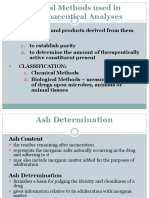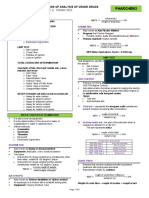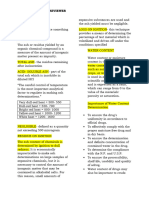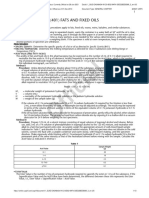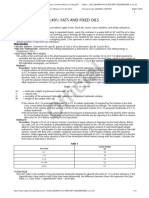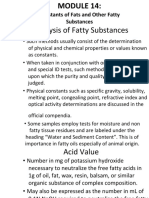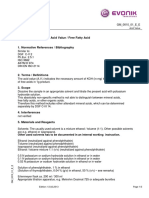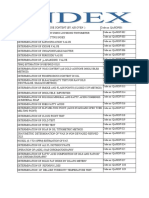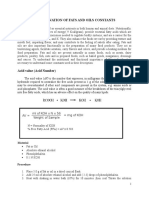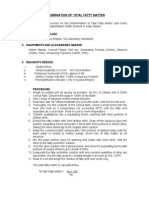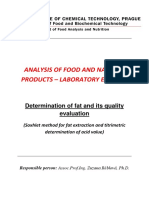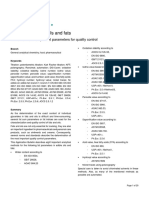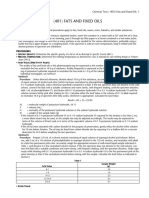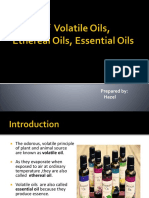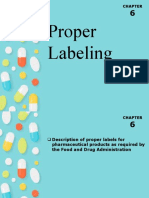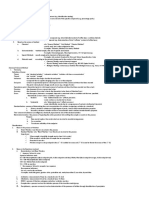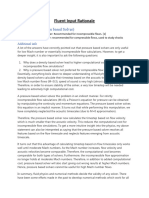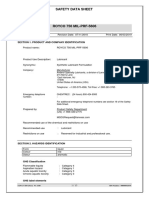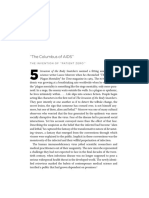Pharmaceutical Analysis 2: Instrumental Methods of Analysis
(Review of Analysis 1 and Introduction)
Gravimetric Analysis -measured using a Cassia flask
-aka “Loss in weight after drying” -reagent used: alcoholic KOH
-dry oven: 110-120oC (unless specified by USP) -the phenol content of the sample (if there is) will react to the
Sample + Precipitant Precipitate Weighing % Purity of Sample alcoholic KOH producing phenolates
Aldehyde/ Ketone Content Determination
Special Method of Analysis -aka “Bisulfide Method”
I. Ash Content Determination -reagent: Na2SO3 Solution
-ash represents the inorganic component of the sample
-Flame color and temperature: IV. Test for Fats/Fixed Oils
Very dull red heat - 500-550oC Oils/Waxes- esters of high molecular matter (with a longer straight chain R-OH
Dull red heat - 550-700oC portion)
Bright red heat - 800-1,000oC A. Acid Value
Yellow red heat - 1,000-1,200oC -aka “Acid Number”
White heat - 1,200-1,600oC -number of milligrams of KOH required to neutralize the free fatty acids in
A. Total Ash Determination one gram of the substance
-residue remaining after incineration -an example of direct titration (VS: 0.1N alcoholic KOH; endpoint: faintly
%TA= weight of TA/weight of sample (100) pink after shaking for 30 seconds)
B. Acid Insoluble Ash -formula: AV= (N x V x mEq KOH)/ 1g of sample
-residue remaining after treating total ash with 3N HCl unit of expression: mg/g
-silicate component of a sample is known to be resistant to acid B. Ester Value
%AIA=weight of AIA/weight of sample (100) -aka “Ester Number”
C. Sulfated Ash -number of milligram of KOH required to saponify the esters in 1g of the
-a modification of AIA, but uses sulfuric acid instead of HCl substance
-residue remaining after treating total ash with 3N Sulfuric Acid -an example of a residual titration (First VS: 0.5 N alc KOH; Second VS:
%SA=weight of SA/ weight of sample (100) 0.5N HCl)
-formula: EV= [N (Va – Vb) x mEq KOH]/ 1g of sample
II. Water determination unit of expression: mg/g
-moisture/ water content affect the shelf-life, processibility, usability ad quality C. Saponification Value
of a product -aka “Koettsdorfer Number”
A. Method I: Titrimetry aka “Karl Fischer Method” -number of milligrams of KOH required to neutralize the free fatty acids &
VS: KFR contains anhydrous methanol, Iodine Solution, Pyridine, SO2 saponify the esters in 1 gram of a sample
Primary standard: K bitartrate -an example of a residual titration
Endpoint: browning of solution -formula: SV= [N (Va – Vb) x mEq KOH]/ 1g of sample
%H2O= Volume of consumed KFR x Water Equation Factor/ weight of the sample unit of expression: mg/g
(100) D. Unsaponifiable Matter
*Water Equation Factor –weight of substance chemically equivalent to -substances that are not saponifiable by alkali are soluble in ordinary fat
the consumed KFR (obtained during standardization) solvents (e.g. ether, hexane)
B. Method II: Distillation aka “Azeotropic Distillation“ “Toluene Distillation” -formula: UM= weight of residue after treatment/ weight of sample (100)
-azeotrope: a chemical mixture with a constant BP (toluene) E. Hydroxyl Value
-substitute of toluene: xylene -number of KOH equivalent to the hydroxyl content in 1 gram of a sample
%H2O= Volume of the extracted toluene/ weight of the sample F. Iodine Value
(100) -number of grams of Iodine absorbed by 100g of sample
C. Method III: Gravimetric Method aka “Loss in weight after drying” -importance: to determine the degree of unsaturation (double bonds) of
-Dry oven: 110-120oC the fatty acid
%H2O= [(Initial weight – Final weight)/ Initial Weight] x [100] -an example of a residual titration
-formula: IV= [N (Va – Vb) x mEq KOH]/ 100g of sample
III. Test for Volatile oils unit of expression: g/100g
A. Specific Gravity -methods:
-used to determine “purity” of oil Method I (Hanus)
Sp. Gravity= weight of substance in air/ weight of equal volume in water -combination of Iodine and Bromine in the test solution
(at 25oC) Method II (Wij)
B. Optical Activity -combination of Iodine and Chloroform in the test solution
-always experimentally determined -Classifications of Oils:
-the ability of a substance to rotate a plane polarized light Non-drying - <100
C. Refracting Index Semi-drying - 100-120
-ratio of the velocity of light in air to the velocity of light in the substance Drying - >120
-used for identification & determination of purity and is measured using
an Abbe Refractometer V. Alcohol Content Determination
D. Test for Specific Compound A. Method I: Distillation Method
Phenol Content Determination B. Method III: Gas-Liquid Chromatography
